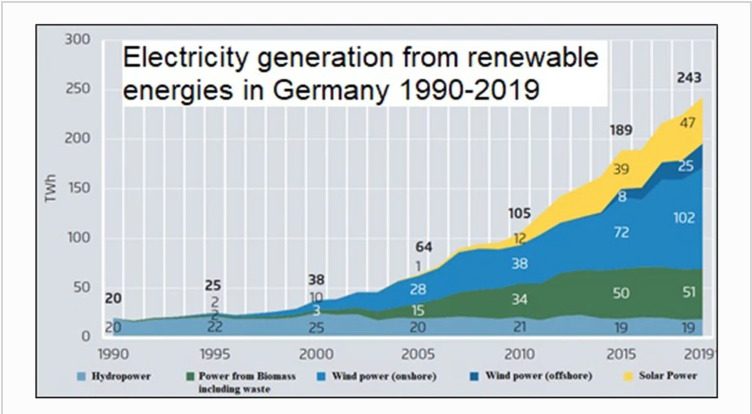Let go of the passion and doomsaying, the fear and the denial, and you will see that climate change is largely a matter of energy. We must produce more energy from renewable sources, which will reduce or eliminate greenhouse gas emissions. This will allow us to avoid catastrophic climate change and ensure that the world continues to grow.
It’s so simple, and it’s also very complicated.
In recent years, zero-carbon sources for renewable energy such as wind and solar have seen remarkable increases in capacity and similarly impressive drops in price. While the International Energy Agency still considers hydropower the “forgotten giant” of low-carbon electricity, the technology of hydropower has been around for decades.
Then there is nuclear power. Nuclear power is a green dream if viewed strictly through the prism of climate change.
Unlike coal or natural gas, nuclear plants “>significantly smaller land area per megawatt of power produced. Hydropower, which has exceeded its natural limits in many countries including the US, is not a good choice for nuclear power. They don’t need to be built on an environmentally sensitive dam.
The accidents at Chornobyl, Fukushima, and Fukushima show that nuclear power can be really bad. But newer plant designs reduce the risk of such catastrophes, which themselves tend to garner far more attention than the Still-flowing deaths due to climate change and air pollution resulting from the normal operation of conventional power plants.
You might think that people who view climate change as a grave existential threat would support the expansion of existing nuclear plants, and cheer the development of new ones.
However, this is often not the case in practice as evidenced by recent events in Germany.
Is a Green green when it is not?
Although the Russian war in Ukraine has caused havoc on global energy markets, perhaps no country has been more vulnerable than Germany.
The Russian exports provided more natural gas to Germany than half the country’s total. This was in addition to large amounts of Germany’s oil and coal imports. Russia has severely restricted the flow of natural gas to Germany since the start of the war, which has left the country in a state of severe energy crisis. The fears are growing as the next winter approaches.
German leaders were faced with a dilemma. With limited natural gas reserves and its highly supported renewable sector unable fully to make up the gap, they had little choice but to turn to the international community for help. They could delay the closing of Germany’s three last nuclear reactors. This was part of Germany’s post-Fukushima stance against nuclear power.
They could also try to restart mothballed coal-fired energy plants and fill in the electricity gap with Germany’s abundant coal reserves.
Based solely on carbon emissions, you would presumably choose the nuclear option. The most polluting fossil fuel, coal, is responsible for five percent of global greenhouse gas emissions. None of these are produced by nuclear power.
German legislators saw things differently. The country’s parliament backed by members of the Green Party in a coalition government passed emergency legislation to reopen coal-powered plants and to increase the production of renewable energies. It would not be possible to restart nuclear power plants that have been closed or to change the timeframe for closing them.
In June, Robert Habeck, Germany’s economy minister and member of the Green Party, stated that gas storage tanks should be filled by winter. This is our number one priority.
Due to that prioritization, Germany, which has seen carbon dioxide rise in the past two years and missed its ambitious emission targets, will emit more carbon in 2022.
Restarting closed nuclear power stations is far more complicated than lighting old coal plants. The plant operators only had enough uranium to last until 2022 so there is no way to replenish nuclear fuel supplies.
That’s not the whole point. Germany, which considers itself a global leader in climate change, grasps the most carbon-intensive source of fuel because it decided in 2011 to completely abandon nuclear power and enshrine what was a planned phase-out into law.
Priorities are important
As accidents like those at Fukushima have shown, nuclear power is not risk-free. The sector’s inability to handle radioactive waste is a problem. It also produces too many new plants late and sometimes billions of dollars over its budget.
However, no energy source is completely safe. Nuclear power with its low emissions compares favourably to other sources. According to one estimate nuclear power causes 99.8 percent fewer deaths than coal, 99.7 percent fewer than oil, and 97.6 percent fewer than natural gas. It is comparable to solar or wind and can produce reliable baseload electricity.
It is implicit to say that your fear of nuclear energy outweighs your fear of climate change. If that becomes the norm, then the climate will be the one to pay.
This fear is slowly losing its traction across Europe and the rest of the world. Thunberg’s tweet was in response to the EU parliament’s decision to label investments in nuclear power stations, as well ll lower-carbon natural gas as “climate-friendly.” Belgium has decided, unlike Germany, to keep open two reactothatich were slated to close, while France announced plans for building as many as 14 more reactors. Even in Japan, the site of the worst nuclear accident since Chornobyl, support for nuclear power is increasing.
In the meantime, the US Biden administration spends billions to subsidize existing plants. States like New York, California, and even California, are trying to keep open plants that were scheduled to close.
To make nuclear power more than a mere hold, it must overcome its safety issues and even greater cost problems. The Breakthrough Institute, an energy- and environment think tank, has released a new report that projects that investments in nuclear reactors, which are smaller and more efficient than current ones, could provide as much as half the US clean electricity generation by midcentury and be a valuable complement to growing renewable resources.
A major role could be played by nuclear power in achieving energy abundance, a lesser-known challenge. The US’s energy consumption per capita has largely remained static since the mid-1970s. This is due to a shift towards efficiency and conservation. It’s good that our energy mix is dominated by fossil fuels. This is despite significant gains in renewable power.
However, experts believe that the slow growth in productivity over the past few decades is linked to the stagnation of energy consumption. It’s no surprise that productivity and economic growth follow the same pattern as energy consumption.
We can create a pathway to true abundance by separating energy consumption and carbon emissions. Vertical farming and water desalinization can all be made more possible if there is low- or zero-carbon energy. This energy will allow us to fight climate change and make enough energy for our daily needs.
Existential threats require existential solutions. If this is how you view climate change, then there are a few reasons to not consider nuclear power as a viable option.



































